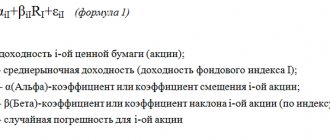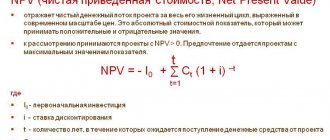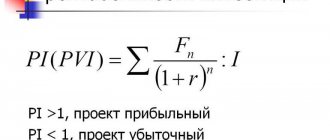02/13/2015 128 378 49 Reading time: 12 min. Rating:
Author
: Konstantin Bely
Today I will tell and show you how to easily and quickly calculate interest on a deposit using a formula, as well as how to calculate interest on a deposit with capitalization using a formula and in MS Excel. What is it for?
Firstly, in order to find out exactly what you will get in monetary terms from placing a deposit in a bank and draw a conclusion about whether such a deposit is suitable for you or not. To be able to compare the conditions of different banks.
Secondly, in order to check the bank: is it charging you interest on your deposit correctly and is it using the correct calculation principle? Of course, now this happens automatically, but a failure can always occur, and interest will be calculated incorrectly, most likely not in your favor. If you don’t notice this, then the bank even less so. In my practice, this happened once.
So, let's look at how to calculate interest on a deposit in different cases.
How to calculate the interest rate: annual or monthly
Often on the websites of organizations there is a special calculator with which you can find out the profitability of the deposit. What to do if such a function is not provided on the site? And the contract is unlikely to contain a reference to the calculation results made by the calculator. It can be changed or removed altogether. It's best to do the calculations yourself.
The calculation of interest at the annual rate includes the formula for simple and compound interest. It is indicated in documents and can be fixed or floating. The latter is more difficult to deal with, since it is difficult to predict. In this case, the basis for the floating rate may be some key parameter, for example, the Central Bank refinancing rate. When it changes with a certain lag, the floating rate also changes. A fixed rate brings more ease to comparative analysis and general understanding.
Options for independently calculating interest on the total deposit amount
Every potential banking client should know how to correctly operate with numbers in order to find out whether 15 or 20 per annum is how much per day. First of all, it is worth considering bank deposits, all the nuances of which are indicated in the agreement for a specific loan. The client deposits certain funds into the account, to which annual interest is subsequently calculated .
Accrued interest on deposits represents remuneration from the bank paid to the client for the right to use his funds.
According to the established rules of the Civil Code of the Russian Federation, deposit owners have the opportunity to carry out the procedure for closing an account at any desired time and withdraw their invested funds simultaneously with the accrued interest due. All details of deposits are required to be reflected in contractual agreements, and annual accrual occurs according to two options.
Simple interest calculation method
Simple interest is interest on a deposit or loan that has the frequency and payment period specified in the agreement, but does not include accrued interest in the previous period. The calculation of the annual interest on a loan is similar to the calculations carried out on a deposit. The picture below shows the formula, where P is the body of the loan, and S is the accrued interest. In common practice, the number of days in a year is equated to 365 or 366 (rarely 360), and in a month to 30 days.
Based on the formula, you can see that the amount of simple interest depends on the interest rate and the term of the deposit. However, the factor of accrual frequency has absolutely no impact on the final profitability. This is because interest is not added to the principal amount of the deposit.
In turn, if the terms of the contract indicate that interest is paid at a certain frequency, and not at the end of the term, then the final yield is equal to the amount of interest. An example is monthly accrual.
Calculation of interest on deposits in leap years
In a leap year there is 1 more working day (366). This imposes some nuances on the calculation of interest. Let's consider two options.
1 The deposit is opened in a leap year and closes in the same year. Then there are no difficulties. You just need to divide the number of days of deposit by 366.
Profit = Amount × [Number of days]/366 × rate
2 If the deposit lies part of the year in a leap year and part in a non-leap year. For example, a deposit opens on September 1, 2021 for 181 days. The rate is 8%. The calculation will have to be divided into two stages:
Profit = Amount × (122/366 + 59/365) × bet
It is necessary to count the number of days in a leap year and divide by 366. The remaining days will not be in a leap year, so we divide by 365.
Example of using simple interest
Condition of task No. 1
The client contacted the bank with a request to place a deposit for a period of six months. For 6 months of deposit, the rate is 8.7% per annum with monthly accrual. Minimum amount to complete a transaction: 30,000 rubles.
So, interacting with the bank on the presented conditions, we get:
Amount of interest = 30,000 x 181 x 8.7: (100 x 365) = 1294.3 rubles. It should be noted that calculating the annual interest on a loan would look exactly the same.
But due to the fact that the condition says monthly interest payments, the amount received will be paid in six payments. The number of calendar days affects the size of these same payments. Let’s say a client applied in December, then:
- Interest for December, January, March, May = 30,000 x 31 x 8.7: (100 x 365) = 221.67 rubles.
- Interest for February = 30,000 x 28 x 8.76: (100 x 365) = 200.22 rubles.
- Interest for April = 30,000 x 30 x 8.7: (100 x 365) = 214.52 rubles.
As a result, for 6 months the amount of the deposit or loan with accrued interest will be:
- Amount with interest = 30,000 x (1 + 181 x 8.7: (100 x 365)) = RUB 31,294.274. Or simply 30,000 + 1294.3 = 31,294.3 rubles.
Deposit calculator with replenishment
In addition to capitalization, the Bankiros.ru calculator takes into account such an important option as replenishment - the ability to additionally deposit your savings, thereby increasing profitability. The agreement with the bank must specify the minimum replenishment amount: this amount in most cases starts from 1 thousand rubles (100 dollars or euros if we are talking about a foreign currency deposit). You can top up your deposits with this option an unlimited number of times.
Replenishable deposits
Method of calculating compound interest
Payment for the use of money received (in the case of a loan) and remuneration for transferring own funds for storage (in the case of a deposit) are mainly calculated using the second type of return. The calculation of compound annual interest includes interest that takes into account both the accrual on the deposit amount and the amount of interest previously accrued on the deposit. At the same time, the frequency and duration of the contract are also included in the conditions for calculating the capitalized interest. Below is the formula for calculating the amount of interest. Annual values are cumulative. The following is an example of which method of calculating interest is most beneficial for the consumer.
The formula for calculating annual interest shows that a deposit or loan with capitalization must necessarily have periodic interest accrual. This leads to the fact that the term of the banking agreement, divided into periods, contributes to the accrual of interest for each time period with subsequent capitalization. The month acts as the most popular period for calculating interest, the income of which is determined by calendar days. Therefore, the total profitability of the deposit is derived from the amount of interest accrued for individual periods.
How to take into account the replenishment in the calculator?
- Click on the “Add replenishment” button;
- Specify the frequency of replenishment (once/daily/weekly/monthly);
- Enter the amount and click “Calculate Deposit”.
If the deposit is subject to capitalization, it will also apply to the amount of replenishment. The online calculator will take all parameters into account before presenting the final calculation.
Question answer
► For what period should the deposit be opened?
You need to focus on your own need for money, but for all deposits the rule applies: the longer the placement period, the higher the income. This is due to the fact that it is profitable for the bank to manage the client’s funds for as long as possible. Therefore, the greatest profit can be obtained if you open a deposit for a long period (without partial withdrawal).
You can also familiarize yourself with all deposits from 6 months and more.
►Is it possible to withdraw the deposit ahead of schedule?
There are deposits that imply the possibility of partial withdrawal. Such accounts can be cashed out up to the minimum balance - the part of the deposit that, according to the agreement with the bank, must remain inviolable. At the same time, the client does not lose in profitability. But if you withdraw an amount greater than the minimum balance or even withdraw an irrevocable deposit, the bank will apply penalties. This is usually expressed in terms of interest - the client will receive a minimum income for the time that his money was in the bank.
►How much money can I save on my deposit?
Depends on the terms of the deposit. For example, let’s imagine that a bank client is ready to place 350 thousand rubles at interest for a year. The bank he contacted offers a rate of 6.50% with capitalization. We calculate the return on the deposit using the Bankiros.ru online calculator and get:
- Accrued interest - 23,389.15 rubles;
- The effective interest rate is 6.70% taking into account capitalization.
If you regularly withdraw interest without adding it to the “body” of the deposit, the profitability will be lower (capitalization will not have the effect). Otherwise, the yield on deposits depends on the amount, interest and placement period: the higher they are, the more money the depositor will earn.
Check out the most profitable deposits on the site.
►How to choose the best deposits using a deposit calculator?
To choose the most profitable deposit for yourself, you need to calculate each attractive deposit using a deposit calculator with additional capitalization, and then compare the resulting values. Before signing a deposit agreement, it is recommended to contact the bank and check the data provided by the deposit calculator. This must be done, since the contribution calculation calculator always gives a preliminary one. Your savings may differ from those calculated by the program.
Example of using compound interest
Next, we will derive the profitability of a savings deposit with the same condition as in the previous example. The exception is the use of the capitalized interest method.
Problem No. 2
Deposit terms:
- Investment - from 30,000 rubles.
- Deposit period - 6 months (December-May).
- The frequency of interest accrual and payment is monthly with capitalization.
- The deposit rate is 8.7% per annum.
The calculation algorithm is given in the table below.
| Month | Amount, rubles | Amount of days | Interest | Total by month, rubles |
| 1st month | 30 000 | 31 | 8.7: (100 x 365) | 221,67 |
| 2nd month | 30 000 + 221,67 | 31 | 8.7: (100 x 365) | 223,31 |
| 3rd month | 30 221,67 + 223,31 | 28 | 8.7: (100 x 365) | 203,19 |
| 4th month | 30 444,98 + 203,19 | 31 | 8.7: (100 x 365) | 226,46 |
| 5th month | 30 648,17 + 226,46 | 30 | 8.7: (100 x 365) | 220,77 |
| 6th month | 30 874,63 + 220,77 | 31 | 8.7: (100 x 365) | 229,77 |
As a result, after six months, the amount of compound interest became equal to 1,325.17 rubles, the total amount of the deposit with interest was 31,325.17 rubles. Thus, the deposit with interest capitalization for 6 months brought additional income in the amount of 30.87 rubles.
The annual interest rate on the loan would be calculated in the same way. In the situation of taking out a loan or applying to small financial organizations, such as microfinance organizations, interest charges are made in the same way. The difference lies in the wording of the name. In the case of a deposit, this is the profitability; in the case of a loan, this is the client’s commission or the profitability of the bank itself.
Tax on income from deposit
From 2021, a tax has appeared on income from deposits exceeding 1 million rubles. There are also two conditions when there is a mandatory tax:
- If the deposit rate is higher than the key rate by 5 basis points;
- For foreign currency deposits over 9% per annum;
If one of two conditions is met, then tax is taken only on excess income. The tax rate is 30% for residents of the Russian Federation and 35% for non-residents.
For example, if the key rate of the Central Bank is 8%, and the bank deposit is 15%, then the excess is 2% (8% + 5% = 13% - the maximum possible rate without tax). Tax will be taken on income from 2%.
Note The current key rate of the Central Bank is 5.00% (changed on April 23, 2021).
Basic rules for calculating remuneration
Financial calculations also include analysis of the investment process. After all, annual interest is used not only to calculate traditional methods of preserving funds, that is, for savings deposits, but also to evaluate investments in the stock market. Below are the basic calculation principles relevant to all types of capital increase.
If interest is cash receipts as income, then simple and compound interest are the rates at which this income is accrued with a certain frequency on the body of the deposit or debt. When considering the two types of interest, you can see how an individual receives a greater return if the bank uses compound interest. This is due to the constant reinvestment of accumulated income.
Calculation of the annual loan interest rate
Lending is very popular among bank clients. And the annual rate established by the bank’s norms is the main and fundamental one for the client. By the way, the amount per annum directly affects the amount that the borrower will have to deposit into the account monthly. And no matter how attractive the rate offered by financial institutions may look to future borrowers, you need to understand that no financial institution will lend to clients for free.
Example of future value of money
Task No. 3
Find the future value (FV) of an asset if you plan to invest 5,000 rubles at 10.5% per annum for 3 years.
In this problem, the current value (TC) will be 5,000 rubles, and the CV of the same funds is calculated in two ways. The first without reinvestment, and the second taking into account the reinvestment of these funds. Then these calculations act as an analogue of simple and compound interest.
The formula for using compound interest is as follows:
Where:
- FV (Future Value) is the future value of money.
- PV (English Present Value) - current or original cost.
Using simple interest looks the same, but the interest rate written in brackets is not raised to a power, but multiplied directly by the number of periods.
Then in the problem presented above, the BC using simple interest will be equal to:
- FV = 5000 x (1 + 5 x (10.5: 100)) = 5000 x 1.525 = 7625.
But using compound interest is different:
- FV = 5000 x (1 + (10.5 : 100))^5 = 5000 x 1.647 = 8235.
The difference in profitability will be 610 rubles. Hence, it is much more profitable to interact with financial institutions that use compound interest for their calculations.
To compare cash inflows from investments made at different times, you need to bring them to the same point in time. This procedure is called discounting if financial receipts are reduced to the initial period, and accumulation if to a future point in time. However, in both cases the formula for calculating interest does not change. Only the location of the percentage multiplier changes.
Examples of deposit calculations
To demonstrate the calculation of interest rates on simple and complex deposits, it is worth applying the already indicated formulas. As an example, let’s take opening a deposit worth 500,000 rubles. lasting one year at a bank rate of 12%.
Simple deposit . We substitute our numbers into the existing formula: (500,000 x 12 x 365 / 365) x 100. We get a total of 60,000 rubles. That is, the investor’s profitability will be 60,000 per year.
Complex contribution . We will proceed from the same figures, taking into account the opening of a deposit for a period of 3 months. We substitute them into the existing formula:
- Income for the first month: (500,000 x 12 x 3 / 365) x 100 = 4,930 rubles.
- Income for the second month: ((500,000 + 4,930) x 12 x 3 / 365) x 100 = 4,980 rubles.
- Income for the third month: ((500,000 + 4,930 + 4,980) x 12 x 3 / 365) x 100 = 5,029 rubles.
From the data obtained, it can be understood that the most profitable are complex deposits, opened with the condition of capitalization of interest . And this benefit is obvious when considering deposits made for the same amounts with the same interest rate. Potential investors need to take this into account.
Using Excel to count
Using a computer program to do the calculations is a more advantageous strategy. Automation of calculations allows you to quickly process large amounts of material.
Entering simple and compound interest formulas simplifies the calculation procedure. To do this, you don’t need to write it down every time, just enter and drag the formula through the cells, the number of which is equal to the number of periods. This simplifies the process of analyzing investment strategies or selecting bank offers.
Formula for calculating capitalization rate
The basis for calculating QC is information from the company’s balance sheet. Therefore, investors, creditors, partners, government agencies can determine it without turning to the subject being assessed for data:
- equity and reserves (p. 1300);
- short-term liabilities (line 1500);
- long-term liabilities (p. 1400).
Important point! If a company's short-term liabilities (up to 12 months) are less than 5% of total debt, then they are not taken into account when calculating financial leverage.
In general, the formula for estimating the business risk coefficient can be presented as follows:
CC = (DO + KO) / SC, where:
SK – equity capital;
KO – short-term liabilities;
DO – long-term obligations.
For ease of use of the capitalization indicator in practice, it makes sense to express the formula for its calculation through the lines of the balance sheet (new form):
CC= (line 1400 + line 1500) / line 1300
In a simplified form, the formula looks like: CR = line 1400 / line 1300. In this case, it reflects the most stable elements of the organization’s liabilities.











